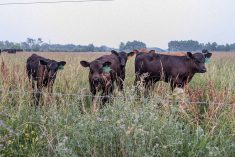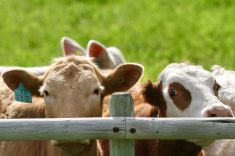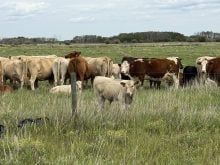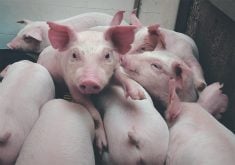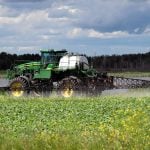Research conducted as part of a new hen house study shows feed efficiency in cage free systems can be quite good
According to a U.S. hen house environment study, not all systems are created equal for brown and white egg layer performance.
“When we look at per capita egg consumption in the (United States) specifically, we see an absolutely dramatic increase there,” said Dr. Benjamin Alig of North Carolina State University. “One of the main (reasons) being that eggs have stayed incredibly affordable and accessible to all different kinds of people.”
Alig presented his research comparing white and brown egg layer performance in conventional intensive cages, barren and enriched colonies, cage-free housing, and free-range (brown layers only) during the Poultry Industry Council’s November conference in Guelph.
Read Also

Mixed results on new African swine fever vaccine
The new African swine fever vaccine still has issues, but also gave researchers insight into how virus strain impacts protection against the deadly pig disease.
In 2021, statistics showed 30 percent (96.1 million) of U.S. hens were raised in cage-free environments, and the number is climbing.
Research shows U.S. consumers are driving demand for cage-free eggs because of animal welfare concerns, and retailers, whether in the grocery or restaurant sector, are providing cage-free products to meet those demands.
While cage-free systems save on steel and wire costs, Alig explained higher labour and birds-per-acre land costs could affect pricing and producer pressure.
“For brown egg layers, free range and colony cages have the best egg production and highest feed consumption,” said Alig. “However, cage-free and free-range actually have the best feed efficiency of all the environments.”
Studies indicate birds perform best when raised in a similar system to the one they will lay in. The research chicks were brooded, reared, and placed in the same housing system they’d lay in, including those in cage-free and free-range housing, at 13 to 14 weeks old to acclimatize before beginning to lay.
Brown egg layers showed an 82 percent production rate in free-range housing followed by barren and enriched colonies at 81.2 and 80.8 per cent, respectively.
Conversely, cages topped white egg layer production at 84.6 per cent; however, enriched colony and cage-free housing followed closely at 84.2 and 83.4 percent, respectively.
“(White egg layers) in barren colony cages consumed more feed than any other environments, whereas the cage and the free range consumed less feed,” explained Alig. “The free range consuming the least amount of feed and higher production was kind of surprising to us.”
Equally surprising was the feed efficiency of cage-free and free-range brown egg layers at 0.47 grams of feed per grams of egg (GF/GE), with cage housing the next closest at 0.45 GF/GE.
White egg layer feed efficiency presented a tie between cage and cage-free housing at 0.5 GF/GE, with enriched colony a close second at 0.48 GF/GE.
When Alig assessed egg weight, free-range brown layers topped the chart at 63.7 grams per egg, with conventional cage eggs second at 60.5 grams per egg.
White egg layers again excelled in a cage environment with 61.6 grams per egg but underperformed in cage-free environments at 60.5 grams per egg.
Brown layers maintained a solid track record with free-range birds producing 77 percent of USDA Grade A extra large eggs, while white layer extra large egg production logged 70 percent in conventional cages.
The trend maintained for production, with free-range brown layers producing 77 percent of USDA Grade A extra-large eggs, while conventional cages accounted for 70 percent of white egg layer extra-large egg production.
For large eggs, the housing flipped as caged brown layers produced 31 percent, and cage-free white layers hit approximately 32 percent.
“This was probably due to the nesting material they had access to. The cage-free and free-range were allowed to lay in boxes with the shavings as well as an AstroTurf base, whereas for the other environments, these hens laid their eggs on wire cages,” Alig said.
Each bird encountered the lowest egg loss in cage-free or free-range housing, while colony cages logged the highest loss, likely due to a central laying tendency increasing breakage.
Similarly, barren colonies reported the highest hen mortality rates at 36.9 per cent (brown) and 31.3 per cent (white) due to broken bones and blunt force trauma. Enriched colony mortality was significantly lower at 19.4 and 15.6, respectively.
“What we found was in meeting the cage height standards, it allowed these birds to be groomed to jump and fly when they were more active… (causing) them to crash into the sides of the cages, injuring themselves,” Alig shared, adding enrichment may calm them or minimize harmful activity.
The lowest mortality rates were in free-range for browns at 6.7 percent and both birds in cage-free environments at 17.2 percent for browns and 5.2 percent for white.
“We did see the free-range birds, the brown layers, had higher body weights (2.21 kilograms per bird) than other environments,” Alig said. “This could be, perhaps, due to the access to high fibre range forage.”
Previous research suggests stress levels affect egg quality, potentially correlating with Alig’s finding that brown layers in free-range environments produce better egg quality and higher secondary metabolite levels.
Using reflectivity, Alig discerned that free-range brown layers produced darker shells while barren colony birds produced much lighter shells, suggesting a negative impact due to stress levels and behaviour. Additionally, free-range and cage-free brown eggs produced the darkest yolks and strongest shells.
“What was unexpected was this increase in the egg colouring in the cage-free environment for both,” said Alig. “We do think that they were able to pull some secondary metabolites, some vitamins, and minerals from foraging and other places where their feces were. And we saw a similar trend for shell strength of these layers.”
He said chicken feces could provide calcium, phosphorus, and vitamin D.
Leanne Cooley, L.H. Gray and Son Ltd. poultry scientist, argued Canada is likely the most progressive and invested in its adoption of enriched colony housing and documented outstanding performance in colony cages.
“In Canada, we’re on what I would call our fourth generation of enriched colony housing,” said Cooley. “There are very, very significant differences in performance and grading results, livability results with the design of those systems.”
She suggested he consider collaborating with Canada to further his research.
“If you want to put out meaningful data as it relates to colony cages, you’ve got no better research lab than what we’ve got going here,” Cooley stated. “So, I just want to encourage that level of collaboration with N.C. state.”





